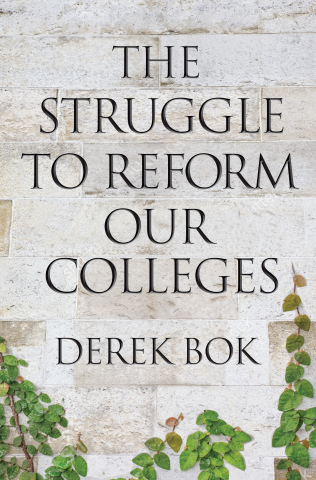A review of a recent non-fiction (and not fictional) work on higher education from the US.
With all of our current travails here in the UK – from the fees and funding review to the OfS juggernaut and from the freedom of speech confection to pensions strikes – it’s easy to forget that US higher education also has troubles by the lorry load. It has often been suggested that the challenges and issues facing HE in North America are a foretaste of things to come in the UK several years further on. If so, leaving aside the uniquely awful US issue of gun crime and campus killings, we have some really big problems heading our way.
Derek Bok, a former long-serving Harvard President, takes on some of these in his recent book The Struggle to Reform Our Colleges and focuses on why efforts to improve American higher educational attainment haven’t worked:
During the first decade of this century, many commentators predicted that American higher education was about to undergo major changes that would be brought about under the stimulus of online learning and other technological advances. Toward the end of the decade, the president of the United States declared that America would regain its historic lead in the education of its workforce within the next ten years through a huge increase in the number of students earning “quality” college degrees.
Several years have elapsed since these pronouncements were made, yet the rate of progress has increased very little, if at all, in the number of college graduates or the nature and quality of the education they receive. In The Struggle to Reform Our Colleges, Derek Bok seeks to explain why so little change has occurred…

The book is fundamentally concerned with improving undergraduate experience and graduation rates to contribute to economic success and is written in a quite noticeably straightforward and direct way. Bok covers the nature of the challenge, who the influencers are, and concludes with suggestions about the way forward.
In terms of the challenge he sets out the scale of the task in relation to graduation rates and educational attainment and addressing the quality of education. Looking at influence he asks whether colleges can change by themselves, what is the nature of student influence and what is the impact of employers, competition, big foundations, government and accreditation bodies. What do all of these actors contribute to attainment rates and the quality of education? Bok then sets out his view on the way forward for increasing educational attainment and improving quality through encouraging reform. In this final section Bok identifies a number of initiatives that he believes could improve the performance of the 4,500 two- and four-year colleges and universities in the US and work in the interest of its 19 million students. He examines the process of change itself and describes the strategy which he thinks is best calculated to quicken the pace of reform and enable colleges to meet the challenges that confront them.
The extent to which the higher education system reinforces social and racial stratification is covered as is the less than wholly positive outcomes of study. Bok though stresses the economic benefits of increasing graduate numbers but also social, health and other personal benefits while at the same time mounting a strong argument for widening participation particularly for Black, Hispanic and low income entrants to the most selective universities. He also argues that undergraduates need to learn more along the way and suggests there is evidence to indicate that current students are not learning as much as their predecessors which means that there is a need to address curriculum, structure, quality and standards too – in other words ‘quality of education is just as important as its quantity’. Whilst in isolation this statement of the exceptionally obvious might appear trite, in this context it is pretty powerful:
Evidence has also come to light casting doubt on how much our undergraduates are learning during college. International tests of basic skills find Americans with college degrees lagging behind their counterparts in many other advanced countries, while surveys suggest that undergraduates are spending much less time at their studies than they did half a century ago. Employers complain about the competence of many of the recent graduates they hire. Families throughout the United States have grown increasingly upset over constantly rising tuitions, and a majority of Americans now believe that colleges care more about the bottom line than they do about their students. A significant fraction of recent graduates wonder whether their college degree was worth the cost. These concerns seem all the more worrisome now that a college education is generally considered to be a necessary step toward finding good jobs, living fulfilling lives, and becoming active, enlightened citizens.
The student factor
Bok rightly identifies the pervasive influence of students and the impact they have on campuses. Fundamentally he sees this as being down to their choice of institution and course, how much and how energetically they choose to study and how they impact on the way their teachers teach.
Few undergraduates today are clamouring for longer readings, harder questions, innovative methods of instruction, or tougher grading standards.
It is perhaps unfortunate he skips over issues such as student representation, the role of students’ unions, societies and activities (which are admittedly differently organised in the US), the importance of students to campus life and culture. Moreover, the broader issues of student life from sports culture, hazing, alcohol and sexual harassment, freedom of speech and political activity are not covered. Rather Bok focuses primarily on the academic and argues that we need to persuade students of the value of their studies to their future, engaging them actively in learning and providing useful and timely feedback on their progress.
The potential impact of new technology, both in support of student retention, through enhanced course delivery and, crucially, in aiding disruptive competition, is explored too. Bok highlights the uncertainty that these developments bring, is somewhat concerned about the impact technology and new competitors in the market may have on existing institutions, but does not really come to any conclusions about the way forward.
The case for reform
The role of government, the large foundations and accreditation bodies plays out very differently in the US but they do have a powerful influence on the work of universities and colleges. Bok covers these at some length here before moving on to a series of recommendations to make courses more relevant and accessible, particularly for adult learners who are studying while working. He then focuses on some more substantial reforms which include:
- improving graduate education to ensure better preparation for teaching for aspiring academics
- creating a properly trained, organised and full-time teaching faculty rather than an army of adjuncts
- significant revisions to the undergraduate curriculum
- serious focus on education research to improve the quality of learning.
Bok notes that whilst many of these activities have taken place and are ongoing in institutions the impact on graduation rates (which remain much poorer in the US than the UK) and enhancing the quality of student learning has been marginal at best. He observes that the impact of President Obama’s attempt to increase access by reducing the cost of attending college was not wholly successful and was implemented in ways which resulted in many states cutting funding to institutions which failed to increase the number of graduates, thereby potentially incentivising them to lower standards to improve graduation rates. Bok argues therefore that there is a really need for schools to find ways better to prepare future undergraduates for university level study but observes that attempts to fix the public school system in the US in support of this aim have not worked terribly well either.
Universities are simply not very good at reforming their teaching and adopting positive innovations in education. Even where good ideas are tried and tested and demonstrated to be effective in enhancing learning, widespread adoption is difficult to achieve, largely because of the highly decentralised nature of institutions, the autonomy of teachers and the absence of incentives to change.
Facing up to the challenges
In conclusion Bok notes that institutions rarely scrutinise themselves rigorously and
many college leaders and their faculties are excessively optimistic about the performance of their own institution.
College presidents are complacent about the preparedness of their graduates for the workplace and grade inflation, while teachers often view their own teaching as in meed of little improvement. This has real parallels in the UK. Bok also argues that to encourage reform universities have to invest more in educational innovations as well as incentivising teachers to adopt them. Combined with enhanced training for the next generation of tutors this would begin to drive the process of change. It is a long game though and he urges institutions, funders and governments to work hard and steadily on this agenda rather than chasing short term high profile initiatives which deliver little material advancement.
It perhaps sounds all a bit staid but Bok has set out an agenda here, based on substantial experience and wisdom, which offers a measured, sane and rational but actually extremely challenging way forward. The Struggle is well worth a read in these most difficult of times and, if we manage not to be distracted by the frequent and current assaults on the academy, he offers a strong and clear message about getting the foundations right for the future. Of course this is only part of a solution but it is absolutely fundamental that universities deliver on this if we are going to progress on the rest of the agenda and face up to the wider challenges.














Many great points for reform and improvement noted, will it be noticed or acknowledged? time will tell. Good one – Bok